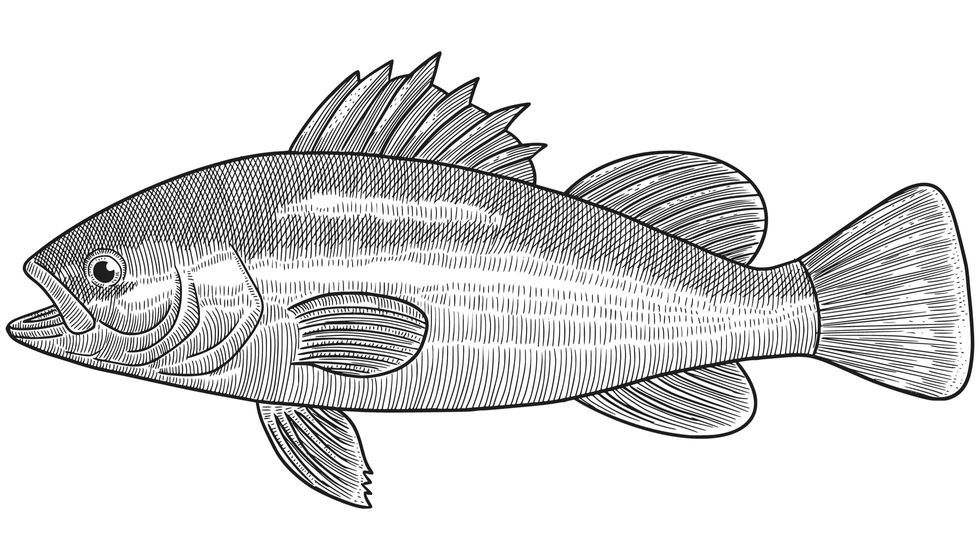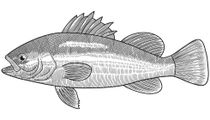The Chinese bahaba (Bahaba taipingensis) is a very large fish, which used to be commonly found in the shallow seas and estuaries within its range, which is mostly limited to the estuaries of the rivers of southern China, as well as its coastal region and the waters of Hong Kong.
It can also be called the giant yellow croaker as it belongs to the family of fish consisting of drums or croakers, known for being able to make a repetitive drumming or thumping noise.
This fish species was known for collecting at estuaries for spawning purposes before moving to deeper waters and is considered to be extremely valuable in the market.
Thus, this species was extensively hunted and caught in by fishermen in the area.
A few years ago, a fisherman had caught a Chinese bahaba, which was estimated to sell in the market for one million yuan. This level of demand for these fish led to a sharp decline in the population of this species, and they are now rarely seen aggregating in an estuary for spawning.
Here are some intriguing facts about this giant species of fish!
If you are interested in knowing about other fish, check out our round goby facts and redbreast sunfish facts pages.
Chinese Bahaba Interesting Facts
What type of animal is a Chinese bahaba?
The Chinese bahaba, with the scientific name, Bahaba taipingensis, is a type of marine fish.
What class of animal does a Chinese bahaba belong to?
This species of bahabas belongs to the class of Actinopterygii, and family Sciaenidae.
How many Chinese bahabas are there in the world?
Giant yellow croakers used to be commonly found in the form of spawning aggregations across its distribution, but after the 1930s, fishing of this species increased which severely affected the Chinese bahaba population.
Now, there are little to no reports of spawning aggregations being formed by these fish, which indicates that their numbers have dwindled considerably and the species is on the verge of extinction.
Where does a Chinese bahaba live?
Chinese bahabas have a very restricted range and are endemic to the marine environment of China. They can be found in the estuary of the Yangtze River, as well as the estuarine areas of the Qiantang River, the Min River, and the Pearl River.
What is a Chinese bahaba's habitat?
These fish are known to prefer the marine environment of shallow and open seas, rocky shores, and estuaries. They are a benthopelagic species, which means that they can live at the bottom as well as the surface or mid waters.
Who do Chinese bahabas live with?
Not much is known about the social structure of these fish, but they were known for forming groups and aggregating at estuaries to lay eggs in the breeding season. They may also use their ability to make sounds to communicate with each other.
How long does a Chinese bahaba live?
The lifespan of the Chinese bahaba is not known. However, the Chinese paddlefish, a species also native to south China, had a lifespan of 9-10.5 years.
How do they reproduce?
The giant yellow croaker (Bahaba taipingensis) reproduces by sexual reproduction and is known to collect in large groups at estuaries or coastal areas to mate and lay eggs. After spawning, they leave the eggs there and move to deeper seas.
The eggs do not receive any protection from their parents and grow up on their own or around other juveniles.
What is their conservation status?
Extreme overfishing has resulted in a decline of over 90% in the population of this species of fish.
Thus, they have been given the status of Critically Endangered by the IUCN Red List, and are even listed as a Grade II State Protected Species in China, but they are still illegally caught and sold in markets due to their high demand.
Chinese Bahaba Fun Facts
What do Chinese bahabas look like?
The giant yellow croaker fish (Bahaba taipingensis) is mainly brown in color with shades of yellow on their undersides and reddish brown fins. Their dorsal fin reaches the tail, along with a lateral line that runs to the tip of the tail fin as well.
A circular black spot covers the base of their pectoral fin and they have yellow lips.

*Please note this image is of a Spotted seatrout fish that belongs to the same family as the Chinese bahaba. If you have an image of a Chinese bahaba please let us know at hello@kidadl.com.
How cute are they?
These fish are generally scarier in looks than cute.
How do they communicate?
Like many other fish in its family Sciaenidae, the Chinese bahaba fish (Bahaba taipingensis) can beat its muscles against its swim bladder, and produce a croaking or drumming sound. This sound is believed to be used for communication between the individuals of this species. Mostly, it is used by males to attract females to the spawning areas for reproduction.
How big is a Chinese bahaba?
The Chinese bahaba is considered to be one of the biggest fishes from its genus. It can measure up to 80 in (200 cm) and is about the same size as an angelshark, and half the size of a megamouth shark.
How fast can a Chinese bahaba swim?
The speed of the Chinese bahaba fish is unknown due to a lack of research.
How much does a Chinese bahaba weigh?
These endangered giant yellow croakers can weigh up to more than 220 lb (100 kg), which is even more than the weight of a skate fish.
What are the male and female names of the species?
There are no sex-specific names for the males and females of this species.
What would you call a baby Chinese bahaba?
The young Chinese bahaba fish can be called juveniles when they are immature.
What do they eat?
The diet of a Chinese bahaba (Bahaba taipingensis) mostly consists of crustaceans such as shrimps and crabs, and may also include smaller fish.
Are they poisonous?
Most species of the genus Bahaba are not known to be poisonous at all.
Would they make a good pet?
It is unclear whether this species would make a good pet as attempts to raise juveniles in captivity have been unsuccessful so far.
Did you know...
The swim bladder is considered extremely valuable within the range of distribution of the Chinese bahaba. It is believed that the bladder has medicinal properties and can cure many ailments. These swim bladders are sold in the market for more than seven times the price of gold for the same weight.
Can we eat Chinese bahabas?
Yes, it is possible to eat Chinese bahaba fish. However, it is not advisable to do so as they are severely endangered within their range of distribution, and fishermen continue to illegally catch and sell these fish due to the high demand associated with them.
Why are Chinese bahabas endangered?
The swim bladder of the Chinese bahaba fish is very valuable and was once sold in the market for a million yuan in the past. The nature of these fish to aggregate in estuaries for spawning also made it easier for fishermen to catch a large number of them at a time.
Continuous fishing by bottom trawling made it harder for juveniles, who are mainly found in estuarine areas, to grow up and reproduce in order to keep their population going.
Reports show that climate change has also caused degradation of the habitat of these fish. All these reasons, combined with the lack of protection given to this species by authorities, have led to this species being endangered.
Here at Kidadl, we have carefully created lots of interesting family-friendly animal facts for everyone to discover! Learn more about some other fishes from our lungfish facts and pigfish facts pages.
You can even occupy yourself at home by coloring in one of our free printable angelfish coloring pages.
Images by Philippe Guillaume.
*We've been unable to source an image of a Chinese bahaba and have used an image of an angelshark instead. If you are able to provide us with a royalty-free image of a Chinese bahaba, we would be happy to credit you. Please contact us at hello@kidadl.com.









